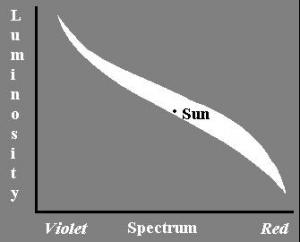A Very Ordinary Star - Part I
Our Sun is an ordinary star, but what does this mean? We have been looking up at the Sun since the beginning, yet it continues to surprise us. Lets take a look at some of the ordinary and extraordinary features of our day star.Stars are born in interstellar gas clouds, mature and die. All sorts of odd objects that were once stars exist, but lets consider main sequence stars like the Sun. These are the stars which have shed their gaseous birth clouds and are now fusing hydrogen into helium for energy. If you plot the luminosity of a star against its color spectrum a striking pattern arises known to astronomers as the Hertzsprung Russell [HR] diagram. Luminosity measures the brightness of a star measured from a common distance. The full HR diagram has regions for unusual stellar objects but we'll ignore them here.The luminosity ranges from more than 100,000 times dimmer than the Sun to more than 100,000 brighter than the Sun. The Sun falls just about in the middle of this range. The peak spectrum for the very brightest main sequence stars actually falls in the ultraviolet. Some of the night sky's most brilliant beacons are these fiercely shining stars. The very dimmest stars radiate primarily in the infrared. Only a few of these very dim [brown dwarfs] stars have been tentatively sighted. The Sun is yellow, just right of the center.When an ideal radiator (also called a black body!) is heated to a couple of thousand degrees, it begins to emit visible light at the red end of the spectrum. As you heat an ideal radiator more, the object first glows orange and then yellow. Logically the next color would be green, but anything this hot seems to glare white to our eyes. Heating an ideal radiator still more will cause it to blaze blue and finally violet. Stars behave very much like ideal radiators. Stars heated to 2,500°K will glow red. If a star reaches 75,000°K most of the stars radiation will be intensely violet. Our Sun's surface is 6100°K which corresponds to a yellow wavelength of light.The luminosity of a star is also directly related to its mass. Large stars have extremely large cores hot enough to fuse hydrogen. Large stars emit energy at stupendous rates. Small stars have very small cores hot enough to fuse hydrogen. This relationship allows us to replace a star's color by its mass. Small stars at the red end of the spectrum have about 8% of a solar mass. Stars at the violet end of the spectrum weigh about 40 solar masses though a few giants may top 100. The Sun is the standard, so it is exactly 1 solar mass. One solar mass is about two billion billion billion tons.If you have a star with a mass 40 times the Sun, its luminosity will be about 100,000 times the Sun. Maintaining a luminosity of 100,000 times the Sun requires the fusing of hydrogen at a rate 100,000 times Sun. Any such star will exhaust its fuel in about 400,000 years. At this time the star leaves the main sequence to face it final fate. Tiny stars with only a tenth of a solar mass fuses hydrogen at a rate of 1/100,000 times the Sun. These tiny stars remain on the main sequence for as long as 100,000 billion years. Our Sun has a main sequence lifetime of about 10 billion years. The Sun has used up about half its life expectancy so far.At the beginning of April, two planets dominate the night sky, Venus and Mars. Venus is the brilliant white object in the south western sky. Other than the Moon and the Sun, it is easily the brightest object in our sky. In fact, it is actually bright enough to sometimes cast a shadow. Find a very dark place sheltered from electric lights with a good view of Venus. Turn your back to Venus and look for a faint shadow. If you use a large sheet of white paper, it may make the shadow easier to see.Our other bright planet is Mars. Over the next few years Mars and Earth will be particularly close together, making Mars easier to see in a telescope than usual. On April 24th, Mars and Earth will be at their closest this year. Mars should be about 16 arc minutes across. Its distance from Earth will be about 53 million miles. If you have a substantial telescope, you may be able to make out features on Mars. Look for the polar cap (a whitish area). In the middle latitudes of mars you may be able to make out some darker areas which are the mountainous areas. If you have filters, either designed for your telescope, or filters for a 35 millimeter camera, they may help. Red filters highlight land features. Blue filters highlight the Martian atmosphere.
- Author:
- Leslie Coleman
- Entry Date:
- Apr 1, 1999
- Published Under:
- Leslie Coleman's Columns


